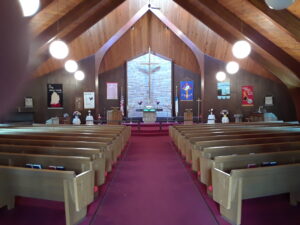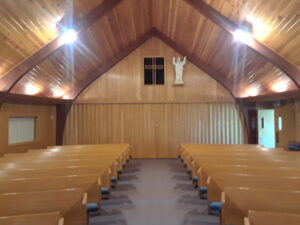The first half of the church year [(1) Advent; (2) Christmas; and (3) Epiphany] has been discussed in What Is Jesus Showing Us During The Church Year? – Part One. The second half of the church year [(4) Lent; (5) Easter; and (6) Pentecost] will be discussed here.
…
Although the showing of Jesus to us is emphasized during the church season of Epiphany, He shows Himself to us throughout the church year. The seasons of the church year are: (1) Advent; (2) Christmas; (3) Epiphany; (4) Lent; (5) Easter; and (6) Pentecost. Beginning with Advent and ending with Pentecost, Jesus shows Himself to us as someone or something.
…
(4) The word “lent” comes from an Old English word meaning “spring.” This makes sense, since the church season of Lent takes place in the spring. As far as the traditional gospel readings for the season of Lent, what do they tell us about Jesus? What is Jesus showing us? The primary emphases during the church season of Lent are (1) our sinfulness and (2) Jesus’ sacrifice to atone for it. The traditional gospel reading for Ash Wednesday, the beginning of the season of Lent, emphasizes our sinfulness (see Matthew 6:1-6 and 16-20). Jesus uses the word “hypocrite” three times, once for each of the three sections of this reading: “Giving to the Needy” [“…when you give to the needy, do not announce it with trumpets, as the hypocrites do…” (verse 2)]; “Prayer” [“…when you pray, do not be like the hypocrites…” (verse 5)]; “Fasting” [“When you fast, do not look somber as the hypocrites do…” (verse 16)]. Is Jesus showing us that we are hypocrites?
The Ash Wednesday ritual of placing ashes on the forehead answers this question. The ashes, symbolizing sin and death (see Genesis 3:17-19, for God’s cursing of Adam), can be seen by others. Normally, we can sometimes hide our sins from others. But, not on Ash Wednesday. Others can see us as God sees us: as a sinner. But, the ashes are in the form of a cross. Others can also see us as God sees us: as a forgiven sinner. The traditional gospel reading for Good Friday, the end of the season of Lent, emphasizes Jesus’ sacrifice to atone for our sinfulness (see John 19:17-30). So, in “the Crucifixion” and “the Death of Jesus,” He shows us that He makes this very sacrifice. When Jesus says “It is finished” (verse 30), He is telling us that His sacrifice for our sinfulness is completed.
(5) The word “Easter” comes from the name “Astarte,” the ancient near eastern fertility goddess. Perhaps this explains the ancient fertility symbols of eggs and rabbits that we find associated with modern Easter celebrations. Perhaps this, too, explains the Christian practice of planting their dead in the earth in anticipation of their dead also rising from the same earth and back to life. The traditional gospel reading for “Holy Saturday,” the transitional day between Jesus’ death on Good Friday and His resurrection on Easter, shows Jesus being planted in the earth in the same way (see Matthew 27:57-66 for the story of “The Burial of Jesus” and the story of “The Guard at the Tomb). This sets the stage for His rising from the same earth and back to life on Easter. The traditional gospel reading for the “Vigil of Easter” (see John 20:1-18) shows us that Jesus has risen from the dead (“The Empty Tomb”) and that He is, in fact, alive (“Jesus Appears to Mary Magdalene”).
The traditional gospel readings for “Easter Day” continue this thought line (see Matthew 28:1-10, Mark 16:1-8 and Luke 24:1-12). These “Easter Day” gospel readings even include an angel to tell those who find the tomb empty that Jesus has risen from the dead and that He is alive: “He is not here; he has risen, just as he said. Come and see the place where he lay” (Matthew 28:6); “You are looking for Jesus the Nazarene, who was crucified. He has risen! He is not here. See the place where they laid him” (Mark 16:6); “Why do you look for the living among the dead? He is not here; he has risen” (Luke 24:5-6). Based on the information listed in this section, we can say that Jesus shows us, during the church season of Easter, that He has risen from the dead and is, in fact, alive.
(6) The church season of Pentecost follows the growth of the Christian church after the coming of the Holy Spirit. The beginning of this can be found in the traditional New Testament reading for the “Day of Pentecost” (see Acts 2:1-21, “The Holy Spirit Comes at Pentecost”). The growth of the Christian church after the coming of the Holy Spirit on Pentecost appears to be entire message that we find in the book of Acts: “The main point of Luke’s account is that God himself was behind the spread of the Christian church; that he empowered its missionaries, through his Holy Spirit; that he guaranteed that the mission would succeed; and that he brought harmony and unity to the thousands of converts who accepted the message of salvation through Christ” (Bart Ehrman, The New Testament, 2000). As far as the gospel readings during the church season of Pentecost, what is Jesus showing us?
The traditional gospel reading for “Pentecost Eve” shows Jesus saying His “Great Farewell Discourse” to His disciples (see John 14:8-21). In this story, Jesus prepares His disciples for His departure: He will be leaving them and going to “the Father” (i.e., heaven), but He will not leave them alone (verses 8-14, “Jesus the Way to the Father”). Jesus promises to send His disciples His Spirit. Although He, Himself, will not be visibly present among them, His Spirit will remind them of His presence in their lives (verses 9-21, “Jesus Promises the Holy Spirit”).
In the same way, the traditional gospel readings for the “Day of Pentecost” (see John 7:37-39, John 15:26-16:15 and John 14:23-31) show Jesus comforting His disciples by telling them that His Spirit will bring them the same comfort that He gives. Jesus tells His disciples that His Spirit will give them spiritual life: “If anyone is thirsty, let him come to me and drink. Whoever believes in me, as the Scripture has said, streams of living water will flow from within him” (7:37-38). Jesus also tells them that His Spirit will continue to guide them down the path of spiritual truth: “…when he, the Spirit of truth, comes, he will guide you into all truth. He will not speak on his own; he will speak only what he hears, and he will tell you what is yet to come” (16:13). And, finally, Jesus tells them not to be “troubled” or “afraid” because His Spirit will be with them: “…the Counselor, the Holy Spirit, whom the Father will send in my name, will teach you all things and will remind you of everything I have said to you. Peace I leave with you; my peace I give you. I do not give to you as the world gives. Do not let your hearts be troubled and do not be afraid” (14:26-27). Based on the information listed in this section, we can say that Jesus shows us, during the church season of Pentecost, that we are never spiritually alone because His Spirit is always with us.

